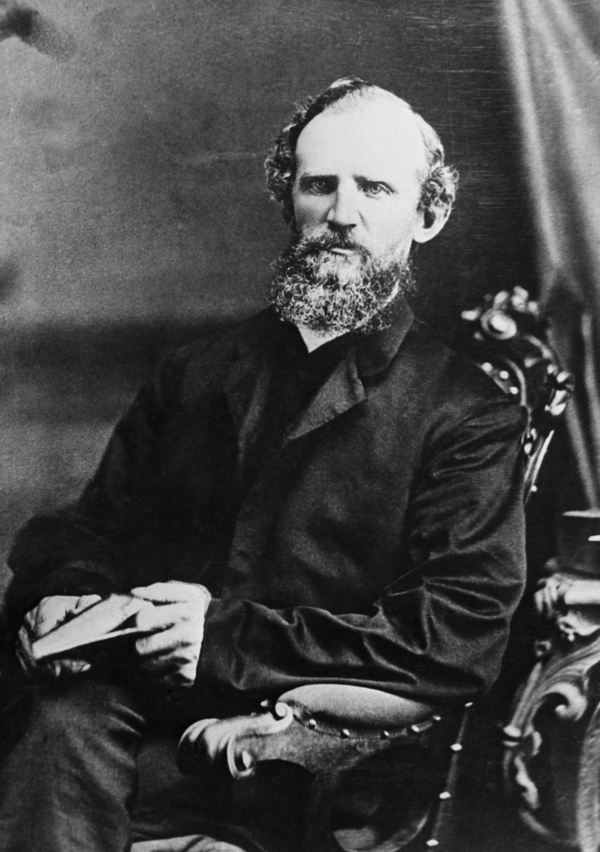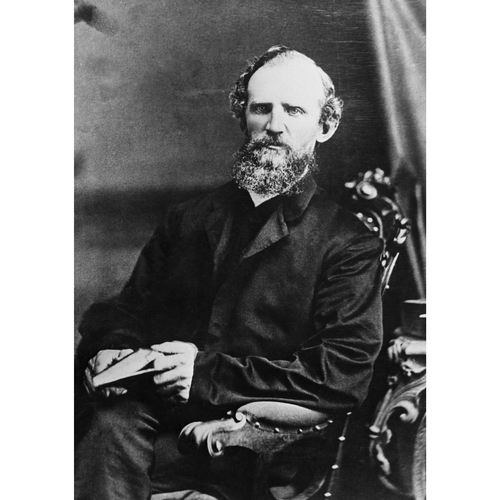
Source: Link
NISBET, JAMES, first Presbyterian missionary to the Indians in the northwest, founder of the settlement at Prince Albert, Sask. ; b. 8 Sept. 1823 in the parish of Gorbals, Glasgow, Scotland; d. 30 Sept. 1874 at Kildonan, Man.
James Nisbet was the son of Thomas Nisbet, a master shipbuilder of Rutherglen on the Clyde, who brought his family to Canada West in 1844 and settled at Oakville on the shore of Lake Ontario. James had served an apprenticeship as carpenter in Glasgow and he worked at this trade for a short time after coming to Canada. He then took the four-year course in theology at Knox College, Toronto, graduating in 1849. He was employed as agent and missionary of the Sabbath School Society of Montreal until January 1850 when he was ordained and inducted as pastor of the Oakville congregation. While at Oakville he did missionary work in winter in distant townships such as St Vincent, Artemesia, and Nottawasaga.
In 1862 Nisbet was selected by the Foreign Mission Committee of the Canada Presbyterian Church to assist the Reverend John Black* at the Red River Mission, and to make inquiries about where and how a mission might be established among the Indians in the Hudson’s Bay Company territory. Nisbet reached Kildonan in July 1862 and readily adapted himself to his new work. In 1864 he married Mary, daughter of Robert MacBeth of Kildonan, a member of the Council of Assiniboia; they had four children.
In October 1862 Nisbet sent the Foreign Mission Committee an estimate of the cost of a mission to the Crees at Berens River on the east shore of Lake Winnipeg. Next he suggested the possibility of missions at the Saskatchewan mines near Fort Edmonton and in the Mackenzie River district. In June 1863 he made a personal appeal at the synod meeting in Hamilton but he could not persuade the delegates to incur new liabilities for an Indian mission. Black shared Nisbet’s disappointment and he proposed to the synods of 1864 and 1865 that the church consider a mission to the Crees in the North Saskatchewan River valley. Finally the synod agreed that Nisbet be designated to the work of a Saskatchewan mission to be opened in 1866.
Nisbet wanted the mission to be “the itinerant kind” and in addition to an interpreter who would accompany him to different bands he needed a trustworthy person to take charge of the mission station. An ordained man was not available but Nisbet obtained the assistance of two first-rate interpreters. George Flett, brother-in-law of Mrs Black (Henrietta Ross), was to come from Fort Edmonton to Fort Carlton to help Nisbet find a site. Part Cree and interested in the welfare of the Indians, Flett promised to join the mission when his term of service with the HBC ended. John McKay, Mrs Nisbet’s brother-in-law, was to act as guide and to supervise the erection of buildings. Like Flett he was part Cree, and he was also a noted buffalo hunter. Two hired men, one of them a brother of Mrs Nisbet, were to help with the work for a year.
The mission party set out from Kildonan by ox-cart on 6 and 7 June and 40 days later reached Fort Carlton on the North Saskatchewan River. There they learned that Flett had not been able to find a band of Crees willing to receive the mission. However; Flett had a farm on the river flats about 60 miles below Fort Carlton and he advised Nisbet to settle there. After inspecting the site Nisbet took his party to the place, which he named Prince Albert. The date of their arrival was 26 July 1866.
The Crees at Prince Albert did not want a mission there because they feared that settlers would come later to take their land and buffalo. Nisbet was patient and tactful, however, and under Flett’s guidance he overcame the Indians’ reluctance. Gifts of food and clothing completed the work of reconciliation. Land was cleared, hay was gathered for wintering the cattle, and log buildings were erected. In September Nisbet and Flett travelled upstream to hold services at the HBC forts and the Cree camps between Fort Carlton and Fort Edmonton. This was to be the only “itinerating” that Nisbet could manage. Flett did not stay long at Prince Albert and McKay could not be spared from other work. Unfortunately Nisbet did not acquire the proficiency he needed for preaching in Cree.
Nisbet believed that permanent results could best be obtained by gathering the children in a school to be taught “the ordinary branches of a common and Christian education,” and to be trained as farmers and skilled tradesmen. The expense of keeping the children in school would not be great once the farming operations were fully established. Indian families were to be encouraged to settle near the mission. In addition to a school for the Indian children Nisbet wanted a school for the children of HBC and mission employees, and he succeeded in getting Adam McBeth, an experienced teacher from Red River, to open the English school in 1867. Nisbet thought that the Indian children should be taught in Cree and only those showing aptitude for learning the language should be taught English. In the summer of 1866 Nisbet himself had tried to teach the syllabic characters to Cree children and he had McKay prepare a Cree reader. Before long, however, he noticed that the Indian children picked up English rapidly and he abandoned the plan of using Cree as a language of instruction. In 1871–72, 26 children were attending the school, but only eight were Indian boarders.
Church services were held in both Cree and English until 1871–72 when English was used exclusively in the morning and English and Cree in the afternoon. In 1872 the religious services were moved from the missionary’s house to a church with seating for 120 persons.
The farm played an important role in the life of the mission. It was intended to serve as an example to the Indians and a source of supply for the mission and other stations to be established nearby. Wheat and barley were harvested in 1867 and in 1868 a crop of 600 bushels of wheat was produced from 17 bushels sown. By 1871, 40 acres were in crop and a threshing machine and small iron gristmill were in use. In “starvation years,” as Nisbet dryly reported, the produce from the farm was a greater attraction to wandering bands than the religious instruction available at the mission.
Nisbet continued to plead for the assistance of a second missionary but he did not get one until 1872. In that year also his work was unfairly attacked. On 2 Feb. 1872 the Western Advertiser of Winnipeg carried an article charging favouritism and mismanagement at the Prince Albert mission„ The charges were said to be based on the statements of former employees and were serious enough for the Foreign Mission Committee to depute the Reverend William Moore to investigate. He arrived in Prince Albert in September 1872 and found that Nisbet, by his own modest standards, had achieved “a splendid success.” However, in Moore’s opinion, too much time and energy had been devoted to farming and not enough to evangelism. More teaching should have been done in Cree and more preaching of the Gospel to itinerant bands. Since the farm was no longer needed as a source of supply or for use as a training school he recommended that it be abandoned. The Foreign Mission Committee was already considering changes in the mode of conducting the work and, in full consultation with Nisbet, now decided to close the farming operations.
But this decision was too late to help Nisbet, who had to spend the winter of 1873 at his old home in Oakville. After his return to Prince Albert Mrs Nisbet’s health rapidly deteriorated and she was taken east for medical attention. She died at her father’s home in Kildonan and Nisbet, worn out by his arduous labours, fell ill and died a few days later.
Nisbet’s main achievement was the establishment of a mission base from which evangelical work was carried on as opportunity offered. He was regarded by his contemporaries as “a singularly unselfish and devoted missionary.” He did more, perhaps, to pave the way for white settlement in the Saskatchewan district than to prepare the Indians for the arrival of immigrant settlers.
McGill University Archives, James Nisbet, letters, accounts; James Nisbet, diary, Prince Albert, 1868–74; James Nisbet, statement of conditions in Prince Albert, 1875. The Home and Foreign Record of the Canada Presbyterian Church (Toronto), III-XIV (1863–75). G. W. D. Abrams, Prince Albert; the first century, 1866–1966 (Saskatoon, 1966), 2–17. Hugh McKellar, Presbyterian pioneer missionaries in Manitoba, Saskatchewan, Alberta and British Columbia (Toronto, 1924), 13–15, 87–91. H. C. Mathews, Oakville and the sixteen; the history of an Ontario port (Toronto, 1953), 267–70. Missionary pathfinders; Presbyterian laborers at home and abroad, ed. W. S. MacTavish (Toronto, 1907), 83–93. E. H. Oliver, “The Presbyterian Church in Saskatchewan, 1866–1881,” RSCT, 3rd ser., XXVIII (1934), sect.ii, 61–94.
Cite This Article
Jean E. Murray, “NISBET, JAMES,” in Dictionary of Canadian Biography, vol. 10, University of Toronto/Université Laval, 2003–, accessed January 23, 2025, https://www.biographi.ca/en/bio/nisbet_james_10E.html.
The citation above shows the format for footnotes and endnotes according to the Chicago manual of style (16th edition). Information to be used in other citation formats:
| Permalink: | https://www.biographi.ca/en/bio/nisbet_james_10E.html |
| Author of Article: | Jean E. Murray |
| Title of Article: | NISBET, JAMES |
| Publication Name: | Dictionary of Canadian Biography, vol. 10 |
| Publisher: | University of Toronto/Université Laval |
| Year of revision: | 1972 |
| Access Date: | January 23, 2025 |



